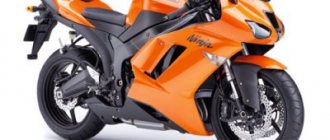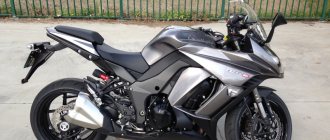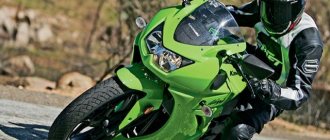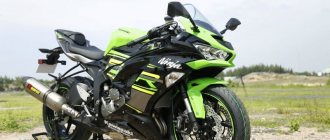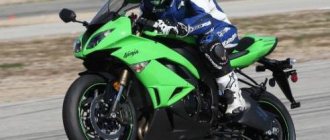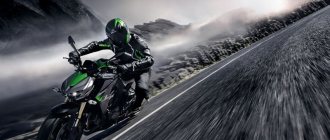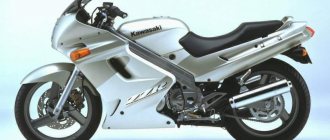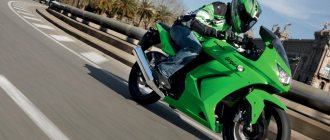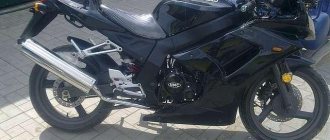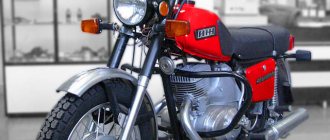Japanese motorcyclesKawasaki motorcycles
No matter how good the Kawasaki Ninja 250 R was, with its smooth engine, comfortable riding position and uncomplicated controls, its time gradually passed, and the question of replacement with something more serious arose.
This replacement for the youth bestseller was the Kawasaki Ninja 300 motorbike, which absorbed the maximum from its predecessor.
The new product first appeared in 2013 , somewhat plunging competitors into the abyss of excitement. And how can they not worry when more than 13,000 Kawasaki motorcycles with a 250 cc engine were sold in Europe over the past year.
And the Kawasaki with increased power is a more serious competitor. But is the Kawasaki Ninja 300 capable of becoming an undisputed leader in this tough race called competition?
Engine
The main changes affected the motorcycle's power unit .
It was based on the engine of its predecessor, whose displacement was increased to 293 cm3. Engine power 39 hp and a torque of 27nM are achieved at about 10,000 rpm, which is slightly higher than that of its predecessor.
The maximum engine speed is similar to that of the class founder and is 13,000 rpm.
But these speeds are achieved without compromising the elasticity of the engine thanks to the installed fuel injection system with two throttle valves. This is also facilitated by special settings of the injection control unit.
has enviable acceleration from 100 km/h , which puts it on par with motorcycles with larger engines.
The new engine is expected to significantly increase its service life due to the use of new lightweight pistons with a short skirt and low-wear Alumite coating.
The exhaust sound of the new product is regulated by a new 2-in-1 exhaust system, in which the diameter of the exhaust pipe and its length are increased, and the muffler itself has a shortened length and a new lining to prevent burns to the rear passenger's legs.
The new generation motorcycle, unlike the Ninja 250, which could be equipped with both a carburetor and fuel injection, has only the latter version of the fuel system.
Each cylinder has two throttle valves that have different controls.
If one is controlled by the throttle, the second is controlled exclusively by the control unit, depending on the engine operating modes.
As a result of this combined effect on the fuel mixture, the motorcycle has good pickup and the highest possible acceleration at any speed.
A characteristic feature of the engine is easy starting in any weather conditions. And all these processes occur with low fuel consumption.
The new Ninja has excellent speed performance. Its maximum speed is recorded at 170.6 km/h, and acceleration to “hundreds” is achieved in 5.6-6.4 seconds.
The Ninja 300 package boasts water cooling with a specially configured fan shroud, which, together with a plastic body kit, helps cool the fuel tank and frame elements of the motorcycle, while simultaneously removing the flow of hot air from the area in which the rider is located.
Simple and lightweight, compact and powerful – these are the main criteria that guided the company when creating the Yamaha-R6, the characteristics of which you will find here.
The history of the manufacturer of this motorcycle knows examples when one or another model with average characteristics turned into a bestseller, a legend on a global scale.
Where to store Kawasaki Ninja in winter
Winter maintenance of a motorcycle is quite a troublesome task. It is better if the garage is heated. At the same time, it must be clean and dry. The motorcycle should be carefully prepared for winter:
- wash thoroughly using plastic shampoo;
- apply polish and wax to the surface;
- rubber parts are treated with silicone spray, and metal parts are treated with WD-40;
- Fully fill the tank with high-quality gasoline;
- it is necessary to seal the muffler, which will protect it from condensation;
- remove the battery and place it in a warm place, recharging it regularly;
- half deflate the tires to prevent them from cracking during storage;
- cover the motorcycle with a cover on top;
Do not cover your motorcycle with plastic wrap. There is no need to drain the oil, as this will cause rusting of the internal surfaces. It is also not worth draining the liquid from the cooling system.
If all these points seem too complicated, you can entrust the wintering of the iron horse to professionals. All you have to do is contact any moto service and you can be sure that nothing will happen to your motorcycle. All storage rules will be observed, and you can observe how they are followed throughout the winter. In the spring, a clean and serviceable motorcycle will be waiting for its owner. For an additional fee, specialists will conduct a full diagnosis of all components and mechanisms, give recommendations for correcting faults, charge the battery, and replace the filter and oil.
Transmission
The basic package is also characterized by the fact that it includes the installation of a clutch made using racing motorcycle technologies.
The slipper clutch controls rear wheel slip during heavy engine braking at high speeds, making riding safer and more comfortable.
In addition, this type of clutch has a softer clutch lever when pressed.
The motorcycle transmission, as it was, remained six-speed. However, a very useful function has been added to its operation - automatic engagement of neutral gear when the motorcycle stops .
Verdict
2017 is the year when the Hyosung GD250R reached our shores and burst into the hot 250cc motorcycle market. There are already many manufacturers exhibiting their small-sized motorcycles here, which will provide tough competition to the GD250R. Traditionally, this market is ruled by Honda, Yamaha and Kawasaki. Later, KTM burst in there, grabbing its share of sales.
The launch of the GD250R is like a breath of fresh air for Hyosung. Externally, it has something in common with many liter bikes and has a redesigned engine. Oh, if only he were really as good as he looks. Unfortunately, it loses to its competitors on almost all fronts.
Sorry Hyosung, but you should try harder.
Chassis
The motorcycle is comfortable and easy to ride, both in urban conditions and on the highway.
The only disadvantages are that at maximum speed the fairings work well only if the driver is pressed against the tank, and that due to the light weight and high side windage of the body kit, the bike is sensitive to side gusts of wind.
Ride comfort is also ensured by the Uni Track rear single-link suspension with a manually adjustable variable stiffness shock absorber.
A comfortable anatomically shaped seat and adjusted distance to the steering wheel allows the motorcyclist to take an almost classic riding position, which contributes to comfortable trips over long distances.
The chassis has changed little , only the front fork settings have changed.
Slightly wider wheels, and the Ninja 300 has 110/70 and 140/70 wheels, respectively, front and rear with a diameter of 17 inches, contribute to more stable behavior of the motorcycle in corners.
Optionally, the motorcycles come with an anti-lock brake system, which adds little to the price of the motorcycle, but is fully justified when driving on slippery surfaces.
A modified panel allows you to control the operating modes of the power unit and the movement of the motorcycle. The panel provides digital speedometer, tachometer, day and trip meters, clock and environmental indicator for monitoring.
Owner reviews of the Kawasaki Ninja 300
Read the review
Having a budget of 150-200 tr. I was choosing between a well-maintained 2002 Honda CB400. and the “fresh” “Ninja” (6000 mileage, now 12,500). I leaned in favor of the last option. After all, the year of manufacture is 2013, and this is a year of warranty and a plus in reliability, which makes it even easier to sell it in the future. I didn’t regret the choice.
Appearance: the designers are great, the girls like it. The rear tires look more “grown-up” than on the 250, because they are wider. I won’t go on about appearance, it’s a matter of taste.
Sitting is comfortable (I’m 170 cm, 66 kg). If you want, lie down on the tank, hide behind the windshield from the wind, if you want, sit up straight like a city. On the “chekushka” the landing is a little more “sporty” - the steering wheel is further away, but this is subjective.
Let's get moving. I immediately note that the engine “pulls” better (or at least pulls) in the mid-speed zone (6000-8000) than on the Ninja 250. The difference in acceleration feels like 0.5-1 sec. The dynamics of 300 cubic meters (in the conditions of the roads of the regional center) are enough (and even more so for a beginner). And the main thing is that it is easier to control acceleration: you can accelerate smoothly from a higher gear, but at 250 you need to immediately engage a lower gear. According to observations on my 39 horsepower 300 car up to 200 hp. per ton in acceleration to the next traffic light they are unlikely to win.
Controls: everything is softly switched and dosed. The slipper clutch (Slipper clutch, wow!) forgives sloppy work with a “soft” handle. Just what a beginner needs. You have to grab the throttle when turning it all the way, but that’s okay.
I would like the brakes to be more effective (that’s why minus one star in the rating for driving performance). Yes, there is ABS - a thing for a beginner! But it relaxes me, I press all the way in a difficult situation without thinking, I willingly apply the rear brake fully, even on wet surfaces (and when the ABS stopped working, I had to relearn). On bumps of bad asphalt, the braking distance with a working system increases frighteningly, but you need to maintain speed.
The main difference with the Ninja 250 is the weight distribution. The 300th is perceived as lighter and more maneuverable. I would like to have a damper on the steering wheel, because... the steering wheel is sensitive to the quality of the road surface (it jerks on ruts, the motorcycle jumps, changing trajectory if this happens in a turn). The width of the front tires affects the quality of the standard tires.
Essential breakdowns:
1.The footrest not retracted sensor caused the engine to stall when engaging first gear, even when the footrest was retracted. An autopsy showed that a flimsy plastic switch near the footrest was stuck in one position. It is in a metal case. I cleaned it, dried it, fixed it in the right position so that it wouldn’t interfere, and removed the fork from the footrest.
2. The ignition units installed by the previous owner of the bi-xenon burned out. (I have been directly involved with cars for several years through my work, and am generally opposed to such interventions in the device!). Result: a lot of time wasted on replacement.
3. The ABS inoperative lamp began to light up while driving and did not go out until the vehicle stopped. The system is not working. There is a self-diagnosis wire under the seat, but did not give an exact answer. I replaced several ABS blocks and washed the sensors. ABS never worked. All that remains is to “test” the wiring. By the way, the control unit costs a lot of money compared to the price of a used Ninja (several tens of thousands of dollars).
Read other motorcycle reviews Full review of the Honda Gold Wing GL 1800
And at the same time, I am very pleased with the set of consumer qualities that this device provided me, as a beginner. It is comfortable and nimble in the city during everyday use, quite dynamic, forgiving of mistakes, does not bother you with breakdowns, and looks great. A sort of Hyundai Solaris among motorcycles, as someone said. Pop music. But I already want to raise the level, to have something more expressive and individual, without “plastic” and with “omnivorous” pendants. It is possible to change class. KTM Super Moto. Only hard rock!
Vladimir Abramov
Where can I buy
List of official dealers in Moscow:
[easy2map id=”3"]
Specifications
The manufacturer of the Kawasaki Ninja 300 officially declares the following technical characteristics, which are almost completely confirmed by reviews from the owners of these motorcycles:
| Model | Kawasaki Ninja 300 |
| Motorcycle type | sport |
| Year of issue | 2014 |
| engine's type | 2-cylinder, 4-stroke |
| Working volume | 296 cc cm. |
| Cooling | Liquid |
| Bore/Stroke | 62.0 x 49.0 mm |
| Number of valves per cylinder | DOHC, 4 valves per cylinder |
| Fuel supply system | injector |
| Ignition type | electronic |
| Maximum power | 29.0 kW {39 hp} / 11,000 rpm |
| Maximum torque | 27.0 N.m/ 10,000 rpm |
| Transmission | 6-speed |
| type of drive | chain |
| Front tire size | 110/70-17 M/C 54S |
| Rear tire size | 140/70-17 M/C 66S |
| Front brakes | Disc diameter 290 petal type with 2-piston caliper |
| Rear brakes | Disc diameter 220 petal type with 2-piston caliper |
| Acceleration 0-100 km/h | 6 sec |
| Fuel consumption per 100 km | 3-4 liters depending on driving mode |
| Seat height | 785 mm |
| Wheelbase | 1405 mm |
| Gas tank capacity | 17 l |
| Motorcycle weight (curb) | 172 kg |
Here is another representative from the Kawasaki lineup - the cruise flagship Kawasaki Vulcan. Read our article and find out the technical characteristics and history of this model.
This motorcycle helmet will not only provide reliable protection, but will also give you the opportunity to look brighter and stand out on the track.
Dimensions and weight
The motorcycle is of average size for a sports bike. And compared to the average cruiser, it is absolutely tiny. The length of the bike reaches only 2015 millimeters. Its width is 715 millimeters. The height of the motorcycle itself reaches 1110 millimeters, while its height at the saddle is 785 millimeters. Wheelbase dimensions are 1405 millimeters.
The curb weight of the bike reaches 172 kilograms, but for versions with ABS it is 174 kilograms. This is a small weight and corresponds to the class of a motorcycle. Thanks to its relatively low weight, the bike is more maneuverable than many of its classmates of more impressive size.
Motorcycle cost
Currently, the motorcycle is offered at a price of just over five thousand euros or six thousand three hundred dollars.
In rubles, this price approximately corresponds to the range from 330,000 to 340,000 rubles.
The cost on the secondary market very much depends on the condition of the motorcycle, its configuration and other indicators.
For a 2013 model they can ask for a price from 185,000 to 240,000 rubles, a used 2014 Ninja 300 can cost from 250,000 rubles.
The Ninja 300, like its predecessor, is positioned in the two-wheeled market as the first motorcycle for novice riders. This is precisely the task facing the company’s designers.
A motorcycle with a modern appearance, easy control and serious technical characteristics is exactly what a young motorcyclist needs at the initial stage of his passion for two-wheeled vehicles.
In the Kawasaki Ninja 300 model, the designers were able to amazingly combine the traditions of the brand, a high level of ergonomics, easy handling and many useful innovations.
This motorcycle is equally convenient for any trip , both on the streets of a big city and on the highway, winding serpentine roads and race track.
Tuning Kawasaki Ninja 300
Read other motorcycle reviews Stels Benelli 600 motorcycle review
An example of tuning a Kawasaki Ninja 300. Photo.
Tuning is the improvement of a motorcycle by installing additional devices and components. The process is entirely individual, as each driver tries to add features that are necessary for him personally. A city biker will try to impress with chrome accessories, a tourism enthusiast will take care of improving the optics and windshield. Some people are missing a clock on the dashboard, while others are trying to improve the chassis.
The rapid growth in the popularity of tuning around the world has determined the offer of well-known companies for entire motorcycle modernization kits. Among the Americans you can Fr. She released a tuning kit for the Kawasaki Ninja250 model. The Kawasaki manufacturer began producing original tuning and accessories for its models. Factory Kawasaki parts and tuning will make your motorcycle more comfortable, stylish and faster.
Photo gallery
We present to your attention a photo gallery of the Kawasaki Ninja 300, which will help you evaluate the external features of the model. Of course, one of the selection criteria is a photo, which is a visual representation of the characteristics stated in the description.
Origin of the company
When you talk about a vehicle like a Kawasaki, you immediately think of a fast and high-quality sports motorcycle. Although initially the main activity of this company was shipbuilding.
This is a Japanese corporation that began its activities in 1896. Today it is one of the world's largest industrial concerns. Currently, the presented manufacturer occupies a leading position in the production of the following products:
- jet skis;
- tractors;
- trains;
- engines;
- small planes;
- helicopters.
Also one of the priority areas is the production of motorcycles and all-terrain vehicles. The company is also engaged in the construction of industrial enterprises and power installations of equipment. Headquarters are located in the cities of Kobe and Tokyo.
Updated samurai
This is how we can briefly describe the Ninja 300 - a modernized 250 model, the history of which begins in 2012, when the Japanese creators decided to release a sports and at the same time inexpensive motorcycle. The machine is characterized by an injection engine, an enlarged cylinder and a modernized lightweight piston.
The engine capacity has also undergone changes, which has increased significantly compared to the previous model and amounted to 296 cubic meters. cm, providing a power of 39 hp. The announced two-cylinder model is also characterized by reduced fuel consumption and an updated ABS system. Kawasaki also took care to equip its new brainchild with high-quality parts and a dense plastic surface, but Korean tires represent its weak point. The design of the model is thought out to the smallest detail, giving the silhouette of the motorcycle an impressive look.
Thanks to its excellent stability and easy gear shifting, the 300 Ninja is perfect for beginners who want to acquire basic motorcycle riding skills, and high-quality disc brakes ensure a safe ride on any road. The motorcycle is specially created for European roads and is capable of reaching speeds of up to 190 km/h.
Who is it suitable for?
For a beginner - 100%. Leave the boring 125s and 200s to the kids. If you want to start your first season with something normal, buy a Kawasaki Ninja 300. First of all, because once you start riding normal equipment, you will get the whole gamut of positive emotions that a motorcycle can give. This is not a product of the Chinese market, but a space shuttle on the road.
In addition, the Kawasaki Ninja 300 has excellent maximum speed and dynamics, so you won’t be trailing behind the flow, turning the gas to full, but leading it.
For an experienced biker - yes. If you read some of the reviews about the Kawasaki Ninja 300, it will become clear why motorcyclists with many years of experience buy it – it’s a pleasure. Moving around the city on such a motorcycle, even an elderly motorcyclist will receive pure joy from the good response to the throttle, the amazing agility of the motorcycle and the ridiculous consumption, in comparison with motorcycles with a capacity of 600 cc.
Competitors
The Yamaha YZF-R3 is practically the twin brother of the Kawasaki Ninja 300, this is clearly visible in the photo. The motorcycles are very similar ideologically, but the Yamaha has a slightly larger engine, which means better acceleration by a fraction of a second and a 10 km/h better top speed.
Honda CBR 300 is another budget sportbike. The smaller volume makes the Honda slightly slower on a straight line, but excellent torque and low weight allow it to show good dynamics.
Comparing the Kawasaki Ninja 300 technical specifications with the presented competitors, we will find that the motorcycles are very similar and it will be possible to find a winner only in a head-to-head bet.
